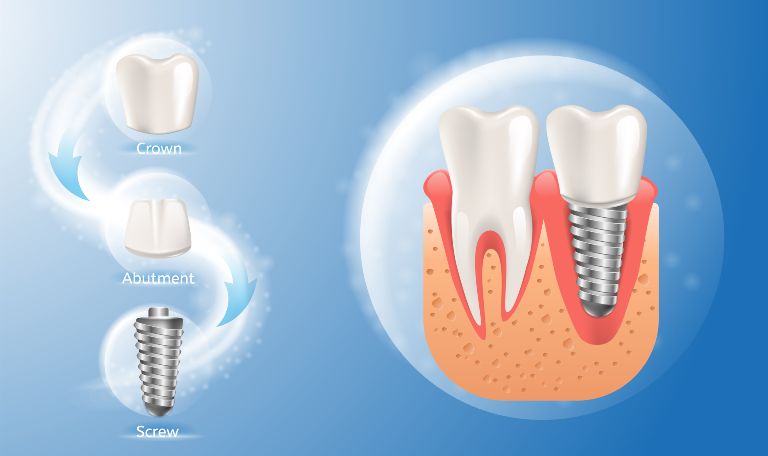Teeth implants are becoming more and more common, and to this day millions of people across the world have gotten them. Whether you’re missing a front tooth or a molar all the way in the back, getting tooth implants is a solution many have chosen and are very satisfied with. However, regardless of how common they are, if you are considering getting dental implants it’s always more reassuring and can be a great stress reliever if you yourself are familiar with the process and not leave things unknown. You may not know what a “bone graft” or an “abutment” is yet, but in this article we’re going to cover exactly what goes on in your regular dental implant procedure and by the time you’re through things should be a lot clearer for you.
It’s always good to know exactly what the pros and cons are to a procedure before you jump into it head first, so we’re going to lay out a couple of points here and list a few advantages and disadvantages of getting dental implants.
And the cons? Well, to be honest, there really aren’t any! The procedure itself involves very little discomfort and with the use of local anesthesia most patients have stated that getting implants is less painful than having a tooth pulled. There is a soreness that sets in for about a day after receiving implants, but this is not very intense and can be easily treated with most over-the-counter pain medication.

Getting tooth implants is a much more permanent solution as opposed to bridges or dentures. Dental implants consist of artificial teeth roots made of metal that are placed into the jaw bone. A special piece called an abutment is attached to the metal roots and this is used to secure the artificial teeth or crowns.
Getting dental implant surgery is a multi-step process. You will need to take time to heal between some of the steps, while during some sessions your dentist will be able to tackle several of the steps in one sitting. It’s common for a team of dental specialists to work together in order to properly customize your implant process.
The first step is having x-rays taken so that a replica of your teeth and gums can be created. The x-rays will also assist your dentist in learning more specifically what condition your teeth and gums are in. If a tooth needs to be extracted, this is when it happens.
Keep in mind that you won’t be able to get your new tooth/teeth put in immediately. Some of the stages require time in between them in order to properly heal. If you’re feeling discomfort then you can ask your oral surgeon or dental specialist to give you a temporary crown you can wear while waiting for the process to be done.
If your jawbone is not sufficiently strong or thick enough to support the implant then it’s necessary to get a bone graft. A bone graft is when an oral surgeon or dental specialist transplants bone into your jawbone. Both bone removed from another part of your body and artificial bone are viable options for a dental bone graft.
It’s not uncommon to need a couple of months to heal after a dental bone graft and before moving on to the next step. If all that’s required is minor bone grafting then it’s even possible to get it out of the way directly before your implant surgery.
The actual implantation procedure is when your oral surgeon puts the metal tooth root into your jawbone. This is the most invasive part of the whole process, yet you still shouldn’t feel much pain especially if you opted for using local anesthesia.
The surgeon will cut the gum to make an opening in order to expose the bone so they can drill the hole to place the implant in. There are multiple options to ease the pain of this process. Your dental specialist will make sure that the entire procedure goes as smoothly and painlessly as possible.
After this is done, your jawbone will need time to grow into and unite with the dental implant. This process is called Osseo integration and generally takes around seven months. It’s imperative that your artificial tooth has a solid foundation as natural teeth do.
There will be a gap where your new tooth will be while you’re waiting for your jawbone to heal. You can use a partial temporary denture to cover the gap while you wait for the healing to complete. The process will be able to continue as soon as you have a sturdy base for your new tooth.
The next step is placing the abutment, which is the piece necessary to attach the new crown. This part of the process is not as invasive as the implantation and definitely a lot less painful. In order to place the abutment, the dentist will open your gum so the dental implant is exposed. They’ll then attach the abutment and close the gum tissue around it.
After this your crowns will be ready to attach. There is also the option of removable crowns which can be snapped on and off for cleaning and fixing purposes. Fixed crowns are attached with cement or a screw and removal is not an option.
Once you have your new dental implants put in it’s very important to keep in mind that you should car for them as you would normal teeth. Things like grinding your teeth or smoking cigarettes will still damage your new dental implants and is not recommended.
Try and keep up good oral hygiene habits. Brush your teeth and floss them every day and make sure to keep your gums clean and free of loose food or other debris. Avoid biting down on hard items such as hard candy or ice. Coffee and tobacco in large quantities will also stain your teeth and turn them an unpleasant yellowish color. Also try and go to your dentist for regular check-ups so you can get useful advice and give your teeth and new dental implants the care and attention they need to stay strong and healthy.

So why would you need to get dental implants? Well the first and most common reason why is if you are missing teeth. Dental implants function and behave the same as normal teeth, so if you’re missing teeth dental implants are a definite bonus. They’ll also last you for life! While a dental bridge will last you about a decade, dental implants can last you for your whole life, especially if treated well and taken care of.
Dental implants also help prevent the loss of bone. If you have an empty space with no tooth then the jaw bone will deteriorate in that space because of the lack of stimulation. Within a year of losing a tooth the bone area can lose up to 25% of its volume, and that’s just the first year. The loss will continue if not treated.
Your dental implants will serve to keep your adjacent teeth stable. Gaps from missing teeth can make teeth unstable causing them to grow crooked and leaving them susceptible to cavities and decay. Not to mention gaps from missing teeth can be a trap for bacteria and food leading to gum disease. Another problem dental implants can fix.
Not only will they help you health-wise, but dental implants are a big bonus to your aesthetic features. With a lack of strong teeth your face can develop atrophy or weakness causing your face to sag. Dental implants serve as strong, sturdy teeth and will prevent this from happening.
There is no specific rule that says exactly how long it will take. Some people will obviously heal faster and some slower depending on how many teeth were extracted and implanted, if bone grafting was necessary and how much, if the jaw bone is healthy enough for the new implants to bond to, as well as other extenuating circumstances. However, it generally takes about a week for the jaw to fully recuperate from your average dental implant surgery.
All in all, the process may take a little time and while there are variables changing how long the whole procedure may take, dental implants are as sturdy as normal teeth and the pros far outweigh the cons.

